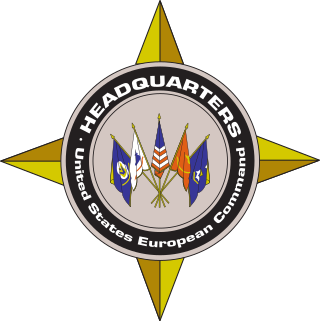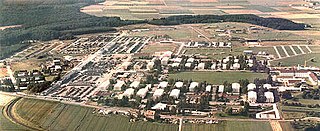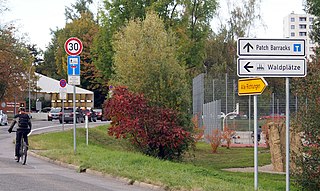Related Research Articles

The United States European Command (EUCOM) is one of the eleven unified combatant commands of the United States military, headquartered in Stuttgart, Germany. Its area of focus covers 21,000,000 square miles (54,000,000 km2) and 51 countries and territories, including Europe, The Caucasus, Russia and Greenland. The Commander of the United States EUCOM simultaneously serves as the Supreme Allied Commander, Europe (SACEUR) within NATO, a military alliance. During the Gulf War and Operation Northern Watch, EUCOM controlled the forces flying from Incirlik Air Base.

Kaserne is a loanword taken from the German word Kaserne, which means "barracks". It is the typical term used when naming the garrison location for American and Canadian forces stationed in Germany. American forces were also sometimes housed in installations simply referred to as "barracks", such as Ray Barracks in Friedberg.
The Kaiserslautern Military Community (KMC) is an American military community in and around Kaiserslautern, Germany, supporting United States Armed Forces and NATO installations, such as the Ramstein Air Base, Landstuhl Regional Medical Center, Kapaun Air Station, Vogelweh Housing Area, Pulaski Barracks, Kleber Kaserne, Daenner Kaserne, Sembach Kaserne, Miesau Army Depot, and Rhine Ordnance Barracks. With around 54,000 people, including military service members, Department of Defense civilians and contractors as well as their families, the KMC is the largest U.S. military community outside of the United States.

Campbell Barracks, in Heidelberg, Germany, was home to Headquarters, United States Army Europe (USAREUR) from 1948 to 2013. It was also home to Headquarters, V Corps and Headquarters, Allied Force Command Heidelberg.
The U.S. Army Garrison Heidelberg was made up of a number of United States military installations in and around Heidelberg, Germany in the state of Baden-Württemberg, along with Germersheim Depot in the neighboring German state of Rhineland-Palatinate. In addition, some NATO facilities were present on the installations. In June 2010, USAG Heidelberg was inactivated and consolidated into its parent unit, U.S. Army Garrison Baden-Wuerttemberg. This was a preparatory move for a complete relocation away from Heidelberg: From 2012 to 2015 the relocation of all U.S. military units marked an end point in the history of the U.S. Army Garrison Heidelberg. The U.S. Army, Europe (USAREUR) headquarters, located in Heidelberg since 1952 as part of the garrison, was moved to Wiesbaden to a newly built installation at Lucius D. Clay Kaserne in 2012. All military installations in Heidelberg were handed over to the German state by 2015 for conversion to civilian use.

Lucius D. Clay Kaserne, commonly known as Clay Kaserne, formerly known as Wiesbaden Air Base and later as Wiesbaden Army Airfield, is an installation of the United States Army in Hesse, Germany. The kaserne is located within Wiesbaden-Erbenheim. Named for General Lucius D. Clay, it is the home of the Army's 2d Theater Signal Brigade, 66th Military Intelligence Brigade and is the headquarters of the U.S. Army Europe and Africa (USAREUR-AF).

Patch Barracks is a U.S. military installation in Stuttgart, Germany. It is named after U.S. Army General Alexander M. Patch (1889–1945).

Kelley Barracks is a U.S. military installation and headquarters of United States Africa Command, and is a part of US Army Garrison Stuttgart in Stuttgart-Möhringen in Germany. The post is administered by IMCOM- Europe.
Coleman Barracks/Coleman Army Airfield is a United States Army military installation located in the Sandhofen district of Mannheim, Germany. It is assigned to U.S. Army, Europe (USAREUR) and administered by the U.S. Army Installation Management Command-Europe (IMCOM-E). Coleman Barracks should not be confused with the former "Coleman Kaserne", located in Gelnhausen. The U.S. Army named the airfield after Lieutenant Colonel Wilson D. Coleman, who was killed in action in France on 30 July 1944.

Ray Barracks was a United States Army installation in Friedberg, Germany until it was closed by the U.S. government in 2007 and returned to the German government. Located in the southern part of the city near the industrial area, the barracks had numerous facilities. The barracks included a firing range for personal weapons qualification, an Urban warfare training site, vehicle maintenance facilities and various recreation facilities. After World War II the barracks were named after First Lieutenant Bernard J. Ray, who was awarded the Medal of Honor for his actions during the Battle of Hürtgen Forest. Ray sacrificed himself to destroy a wire obstacle that was blocking his unit's path. The base was closed in August 2007.
Francis Xavier McGraw was a United States Army soldier and a recipient of the United States military's highest decoration, the Medal of Honor, for his actions during the Battle of Hürtgen Forest in World War II.

The McGraw Kaserne is a former military installation in southern Munich, Germany, which was used by the U.S. Military during the occupation of Germany after World War II. The main building was one of the first ones in Germany to be built using steel frame technology. The kaserne was named after PFC Francis X. McGraw.

The Ernst-von-Bergmann-Kaserne, before called Warner Kaserne by the US Army (1950-1968), it is a military facility in Munich, Germany, which was built by the architect Oswald Bieber between 1934 and 1936. The current name was given in honor of professor Ernst von Bergmann.
Fürst-Wrede-Kaserne has been a military facility in Munich, Germany, since 1936 when it was built by the Munich Heeresbauamt under its original name Verdun-Kaserne. After World War II the U.S. forces renamed it Will Kaserne, and the Bundeswehr renamed it once more in honor of Karl Philipp von Wrede on 17 April 1972.
The Bayern-Kaserne is a military facility in Munich, Germany, originally named General-Wever-Kaserne. The facility was constructed between 1936 and 1938. After World War II it was renamed by the United States forces to Henry Kaserne in honor of Private Robert T. Henry. When it was transferred to the German Bundeswehr, it was renamed once more in honor of General Walther Wever on 9 October 1969.

Kassel-Rothwesten Airfield is a former military airfield located in Rothwesten, a part of Fuldatal in Germany about 5 miles (8.0 km) north-northeast of Kassel (Hessen); approximately 240 miles (390 km) southwest of Berlin.
Robinson Barracks is a military base of U.S. in the Burgholzhof community in the northern Stuttgart district of Bad Cannstatt. Unlike Patch Barracks and Kelley Barracks, also located in Stuttgart, the modern Robinson Barracks is now largely a residential neighborhood for US Department of Defense personnel stationed in the greater Stuttgart area operated and administered by IMCOM-Europe. The installation is named after 1st Lt. James E. Robinson, Jr. (1918–1945), an Army officer posthumously awarded the Medal of Honor during World War II.
Panzer Kaserne, is a U.S. military installation in Böblingen, Germany, part of U.S. Army Garrison Stuttgart. The post is administered by U.S. Army Installation Management Command-Europe (IMCOM-Europe), a legacy from its use as an Army installation since just after World War II. Panzer also hosts the headquarters of U.S. Marine Corps Forces, Europe & Africa (MARFOREURAF) and various Special Operations units of the Army and Navy supporting EUCOM and AFRICOM. There is also a different Panzer Kaserne in Kaiserslautern, Germany

Wallace Barracks is a former German and U.S. Army installation in the Bad Cannstatt district of Stuttgart, Germany. It is located just below the Burgholzhof, near Robinson Barracks and the former Grenadier Kaserne on the site of a former Roman military camp commonly referred to in literature as Kastell Cannstatt.
References
- ↑ Von der Kaserne zum Finanzamt [ permanent dead link ] (German), Munich tax office.